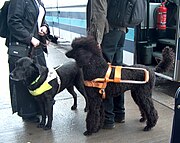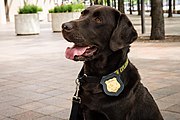Cape (dog)


A cape, jacket, or vest is an article worn by a working dog to identify or assist them in their job.
Many assistance dogs wear capes if nothing else than identification is needed. They often bear the logo of the organization that trained them, the names of companies that sponsored their training, and usually a patch requesting that the dog is not petted or distracted. Although they are not assistance dogs in the legal sense, some therapy dogs wear similar capes to identify them as such.
A police or detection dog might wear a jacket to identify them and/or protect their torso.
Another piece of equipment similar to a cape is the harnesses that guide dogs and some mobility assistance dogs wear for leading, bracing, or pulling. Also, assistance dogs that carry items for their handlers wear backpacks, though sometimes these are also referred to as jackets.
Assistance dog attire
[edit]A cape is a lightweight loose-fitting piece of fabric that lays over the dog's back and has a strap that goes under the ribs and one across the chest. A service vest is usually more form-fitting than a cape. A brace and mobility harness is a tight-fighting strong harness with a handle used to assist people who need help walking or balancing. A pulling harness is a stronger-strapped harness with padding used for assisting in the pulling of wheelchairs. Additional elements for assistance dog attire might include reflective strips, zippered pockets, D-rings, hook-and-loop fastener areas for attaching patches, a top-mount handle, a brightly colored collar or leash, or one with lettering on it. Typical fabrics are breathable mesh, waterproof nylon, or canvas.[1][2]
In the US, the Americans with Disabilities Act does not require a service dog to wear a vest, ID tag, or specific harness.[3] In the UK, there is no requirement for an assistance dog to wear any particular jacket or other marks to show that it is an assistance dog. However, in 2015 the House of Lords Select Committee on the Equality Act 2010 published a report which, among other changes, suggested to amend the laws so that a kitemark might be worn by genuine assistance dogs trained to an appropriate standard and certified for public access. The purpose of such insignia is to deter use of fraudulent assistance dogs and reassure merchants that a particular dog is a legitimate assistance dog.[4]
In over half the states of the US there are laws prohibiting dressing your dog in such a way as to fraudulently represent it as a service animal.[5]
Guide dog attire
[edit]Guide dogs wear a snug-fitting harness with a rigid handle. The blind handler receives direction from the dog through the handle. As long as the harness is on, the dog is "on duty".[6]
Police dog attire
[edit]Bulletproof vests are available for police dogs and are considered essential equipment by some police officers. Others claim that they are too hot for wearing all shift, or a particular dog who was not trained with such attire may not like to wear one. They are fairly expensive.[7]
- Identifying police badge
- Working vest
- A British police search dog
- Customs dog in cape at an airport
Military dog attire
[edit]Military dogs often wear tactical vests (tac vest for short) which are made of durable fabric for a high activity dog, and are constructed in the MOLLE style.[8]
Ballistic vests for dogs (aka body armour or bulletproof vests) are used by police dogs (K-9) and military dogs. Such vests provide "ballistic and edged weapon protection for vital organs while allowing complete freedom of movement". They are made from similar material as bulletproof vests for humans and are expensive.[9][10] Specialty body armor such as the $30,000 ones used by the United States Navy SEALs may be waterproof and incorporate night vision cameras and two-way audio.[11]
- Tactical vest (tacvest) with equipment
- Bullet-proof vest
- Eye protection
- Ambulance dog vest (World War I)
Search and Rescue dog attire
[edit]Water rescue dogs typically wear gear that provides extra floatation and "has handles or attachments for tow lines or rescue gear."[12]
References
[edit]- ^ "Types of Service Dog Gear: Vests, Jackets and Harnesses". anythingpawsable.com. February 14, 2016. Retrieved October 17, 2020.
- ^ "The Best Service Dog Vests And Harnesses (2020 Reviews)". Pet Life Today. December 18, 2018. Retrieved October 17, 2020.
- ^ "Frequently Asked Questions about Service Animals and the ADA". www.ada.gov. Retrieved October 16, 2020.
- ^ "Written evidence - Assistance Dogs Uk". data.parliament.uk. Retrieved October 16, 2020.
- ^ Wisch, Rebecca F (2019). "Table of State Assistance Animal Laws | Animal Legal & Historical Center". animallaw.info.
- ^ "Assistance Dog Etiquette". Guide Dog Foundation.
- ^ "Why Don't All Police K-9's Have Protective Vests?". April 29, 2016.
- ^ "The Ultimate Guide to Tactical Dog Vests and Harnesses". thetacticalexperts.com. Retrieved October 17, 2020.
- ^ Bielby, Kylie (June 6, 2019). "9-Year-Old Raises $100K to Buy Bulletproof Vests for K9 Officers". Homeland Security Today. Retrieved October 17, 2020.
- ^ Hendricks, Larry (January 29, 2011). "A vested interest in fighting crime". Arizona Daily Sun. Retrieved October 17, 2020.
- ^ Chu, Elbert (May 27, 2011). "The Bulletproof Dog That Stormed Bin Laden's Lair". Fast Company. Retrieved October 17, 2020.
- ^ Grace, Kea (May 11, 2019). "Water Rescue Dogs and Water Search Dogs: What's the Difference?". anythingpawsable.com.



















